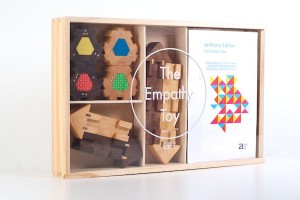Ilana Ben-Ari at work, play. (photo by Laynna Meyler)
For her design diploma thesis project, Ilana Ben-Ari created a toy that people with visual impairments could play with their sighted classmates, developing a language around communication and empathy. The formation of her company, 21 Toys, came after what she saw happen with that project.
“The toys really had an incredible way of using play to teach this abstract and difficult skill [empathy],” said Ben-Ari. “I don’t think we emphasize empathy in schools or in education…. We also don’t teach failure, critical thinking or complex problem solving.”
Ben-Ari, a former Winnipegger now living in Toronto, started 21 Toys with the hope of designing a whole fleet of toys honing often-undeveloped skills in both schools and today’s workforce, including creativity and innovation. These skills, Ben-Ari said, “are really hard to understand … to assess, practise or see.”
Ben-Ari created the Empathy Toy in the belief that the attribute of empathy serves as “not only the basis of communication and collaboration, but the backbone of innovation in design, business and other realms. Not only are these skills not being taught when they should be,” she said, “but they [educators] don’t have the right tools to teach them…. This is why a toy – an aid, tool – comes in handy.”
During Operation Protective Edge, a couple of manufacturers from Toronto sent toys, including Ben-Ari’s, to civilians on both sides. “We wanted to send toys to help in the best ways that we could,” said Ben-Ari. “It’s easy to feel helpless watching the conflict from so far away. We saw this as a chance, in some small way, to insert empathy into the heart of the conflict – by using fun and play to create moments of relief.”
Most recently, the toy is being used in a psychological lab established at Bar-Ilan University for kids and adults suffering from trauma.
Ben-Ari described the Empathy Toy as “3-D, abstract, wooden puzzle pieces that are played blindfolded. One player is given a build pattern of abstract wooden puzzle pieces and one or more players is tasked to recreate that same pattern. The challenge is that everybody is blindfolded while playing.
“Today, we need to focus on getting kids to understand what collaboration is, to start being a bit more creative and, in a way, unlearn what schools have reinforced…. When talking about empathy, it’s not just a soft, fuzzy feeling.”
Saint John’s High School in Winnipeg is using the Empathy Toy for its anxiety, language and literacy classes as a foundation of its new leadership program.
“Looking at someone else’s point of view, putting yourself into someone else’s shoes, and being able to work with and understand other people, [their] thinking and perspectives is very much at the heart of what skills you need to develop, to be able to learn,” said Ben-Ari.
“We’ve found that teachers use it for so many applications. What the toy does is let you introduce empathy in this playful way, but then it acts as a mirror to the lesson. It lets teachers be a lot more creative in how they approach their lessons. If we want kids to be innovative thinkers and creative, we can’t teach them that play is a bad thing, that toys, having fun and playing games are things that happen outside of learning.”

There are three versions of the Empathy Toy: a home version (also referred to as the “light version”) that sells for around $100; a school version that sells for $150-$200, with the price per unit going down with the more toys a school buys; and a version designed for organizations that sells for more than $200.
Schools typically ask 21 Toys to come in and do a professional development workshop with their staff. “Our toys are being used by Free the Children for their staff training,” said Ben-Ari. “We’ve done workshops with the Alzheimer’s society and children’s hospitals. There are a lot of opportunities for training for adults as a professional development tool.”
In British Columbia, Ben-Ari is aware of three places, so far, that are using the Empathy Toy – Holly Elementary in Surrey, the Discovery Centre for Entrepreneurship (Canada’s first Entrepreneurial Leadership Academy) and Coquitlam Open Learning. It is also being used at Winnipeg’s Gray Academy of Jewish Education and at Toronto’s Heschel School. The only place that sells the home version of the toy, apart from the 21 Toys website, is the Canadian Museum for Human Rights in Winnipeg.
Next in 21 Toys’ design sights is the Failure Toy, for which the company has nearly finished the prototype. “This toy will look like a cousin to the Empathy Toy,” said Ben-Ari. “It’ll be an abstract puzzle with funny game dynamics.
“The point of that toy will be to say, ‘Look, failure isn’t this fantastic thing, [but] it’s a very important part of the learning process and we shouldn’t give this signal that it’s bad and something to be avoided.’ Because, not only are we [preventing] ourselves from growing and from pushing ourselves and trying, but there’s no way we can be innovative or creative or even collaborate without having a healthy relationship with failure. You need to understand failure and develop it as a skill.”
Ben-Ari said that entrepreneurs need to go through stages to succeed. She referred to empathy as “the research phase, understanding where you are, context, the people you’re designing for and working with. Then comes failure with prototypes. Then comes the third toy in the fleet, which will be about improvisation. This stage is a lot like brainstorming and being able to build on other people’s ideas.”
For more information, visit twentyonetoys.com.
Rebeca Kuropatwa is a Winnipeg freelance writer.

